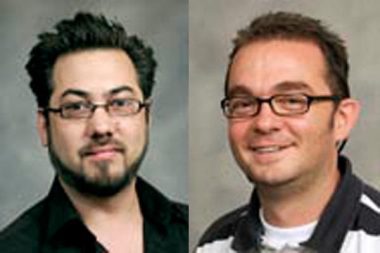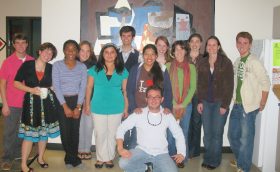There’s a running joke that students live inside an insulated, comfortable “Elon bubble” separate from the outside world. But students aren’t the bubble’s only inhabitants. For faculty-in-residence in the William R. Kenan, Jr. Honors Pavilion, Isabella Cannon International Studies Pavilion and the Colonnades, Elon is home, too.

Elon has housed faculty-in-residence since 2002, when the Kenan and Cannon pavilions opened. A third faculty-in-residence position opened when the Colonnades were built in 2007. Associate Dean of Students Jeff Stein says more opportunities may become available when the new North Area residence halls are built, and the university also is considering models for “residential colleges” where more faculty and staff can live on campus.
Stein says faculty often come to administrators in student life expressing interest in faculty-in-residence positions. Then, a group headed by Dean of Student Life Smith Jackson, Provost Steven House, and other administrators and faculty members make final decisions about which person receives the post.
“We have seen really wonderful engagement between the students and faculty members in residence,” Stein says. “Mentoring relationships develop, and faculty extend what they do in the classroom, interacting with students over interesting topics and discussions.”
Ken Calhoun, faculty-in-residence, Isabella Cannon International Studies Pavilion
When Calhoun’s wife and daughter moved to Boston not long ago, he had no reason to continue living in the family home in Durham. Then he heard about an opening for a faculty-in-residence position in the Cannon Pavilion.
“I’ve always loved international things,” Calhoun says. “It seemed really ideal.”

He rented out his house in Durham and took up residence in the Cannon Pavilion, where he lives with 11 students of various nationalities. He’s even got a meal plan.
“Living on campus is easier than I thought it would be,” Calhoun says. “Students are so busy living their lives, so there’s not too much interaction. I’m like the crazy uncle who takes them out to dinner.”
Calhoun’s primary job as a faculty-in-residence is to foster a thriving living-learning community. Faculty-in-residence are more readily available to provide students with assistance and open new channels of communication. With his fellow Cannon Pavilion residents, Calhoun introduces international students to American culture – and at the same time, he learns from them.
“The hard thing is getting to know them at first, especially the international students,” he says. “The bottom line is that it’s been really rewarding.”
There are drawbacks, too. Though he understands late nights are a routine part of college life, he admits the students can be a little loud at times. And while he enjoys living amid the beauty of Elon’s campus, he says he gets a bit tired of eating the same food and living in a limited environment.
“I go to Boston at least once a month to visit my family, and that’s where I feel like I’m plugged back into mainstream culture,” he says.
In all, Calhoun says, living on campus has enabled him to feel far more connected to Elon.
“It’s made me a real community member, not just a commuter,” he says.
Ricardo Mendoza Castano, visiting instructor-in-residence, La Casa de Español (Colonnades)
Mendoza Castaño, visiting instructor of Spanish, came to be a faculty-in-residence a little bit differently. It began more than 8 years ago.

On Sept. 11, 2001, Mendoza Castaño left Colombia on a flight bound for California, where he planned to work with Hispanic immigrants. Amid the aviation chaos of the day, his flight was able to land and he stayed in the U.S. for four years before returning to Colombia after his visa expired.
Six months after his return to Colombia, Mendoza Castaño was back in the United States, pursuing a master’s degree in Ohio followed by a one-year stay in North Dakota.
“I was so tired of snow, cold and terrible weather, so I started looking for a warmer place to live and saw the position at Elon,” he says.
Mendoza Castaño has taught Spanish and served as the visiting faculty in residence in La Casa de Español, located in Colonnades A, since arriving at Elon in 2008. He describes living in the Casa as a way get to know his students better.
“I like seeing them in that learning process,” Mendoza Castaño says. “The students are very passionate about learning the language.”
Like Calhoun, Mendoza Castaño says the noise is one of the most aggravating prices to pay for living as a faculty-in-residence, but he says it’s a small grievance. He enjoys spending time with students on weekends and evenings, cooking international cuisine, visiting museums and introducing Latin American culture to the campus community. He’s grateful for the unique opportunities a faculty-in-residence has to interact with students.
“I see students in different situations. In class I see them making progress in an academic subject, but living with them, I see progress in their lives,” he says.
Click the link to the right to see the blog for La Casa de Español, which includes a multitude of photos depicting different aspects of life in the learning community.
By Sarah Beth Costello ’11
@Elon Editor Kristin Simonetti contributed to this report.


